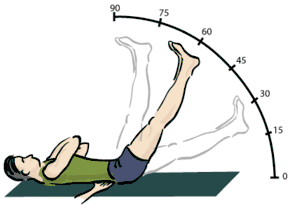Straight leg raise
| Straight leg raise | |
|---|---|
 Straight Leg test sometimes used to help diagnose a lumbar herniated disc | |
| Purpose | determine if herniated disc |
The straight leg raise, also called Lasègue's sign, Lasègue test or Lazarević's sign, is a test done during a physical examination to determine whether a patient with low back pain has an underlying nerve root sensitivity, often located at L5 (fifth lumbar spinal nerve).
Technique
With the patient lying down on their back on an examination table or exam floor, the examiner lifts the patient's leg while the knee is straight.
A variation is to lift the leg while the patient is sitting.[1] However, this reduces the sensitivity of the test.[2]
In order to make this test more specific, the ankle can be dorsiflexed and the cervical spine flexed. This increases the stretching of the nerve root and dura.
Interpretation
If the patient experiences sciatic pain, and more specifically pain radiating down the leg (radiculopathy), when the straight leg is at an angle of between 30 and 70 degrees, then the test is positive and a herniated disk is a possible cause of the pain.[3] A negative test suggests a likely different cause for back pain.
A positive straight leg test reproduces radiating leg pain. If it only causes back pain, then the test is negative. Because this is often misunderstood, it is prudent to add a statement of clarification. For example, "Straight leg test is positive on the left, reproducing the patient's radiating leg symptoms."
A meta-analysis reported the accuracy as:[4]
- sensitivity 91%
- specificity 26%
If raising the opposite leg causes pain (cross or contralateral straight leg raising):
- sensitivity 29%
- specificity 88%
Lasègue's sign
Lasègue's sign was named after Charles Lasègue (1816-1883).[5] In 1864 Lasègue described the signs of developing low back pain while straightening the knee when the leg has already been lifted. In 1880 Serbian doctor Laza Lazarević described the straight leg raise test as it is used today, so the sign is often named Lazarević's sign in Serbia and some other countries.[6]
See also
References
- ↑ Waddell G, McCulloch JA, Kummel E, Venner RM (1980). "Nonorganic physical signs in low-back pain". Spine. 5 (2): 117–25. doi:10.1097/00007632-198003000-00005. PMID 6446157. S2CID 29441806.
- ↑ Rabin A, Gerszten PC, Karausky P, Bunker CH, Potter DM, Welch WC (2007). "The sensitivity of the seated straight-leg raise test compared with the supine straight-leg raise test in patients presenting with magnetic resonance imaging evidence of lumbar nerve root compression". Archives of Physical Medicine and Rehabilitation. 88 (7): 840–3. doi:10.1016/j.apmr.2007.04.016. PMID 17601462.
- ↑ Speed C (2004). "Low back pain". BMJ. 328 (7448): 1119–21. doi:10.1136/bmj.328.7448.1119. PMC 406328. PMID 15130982.
- ↑ Devillé WL, van der Windt DA, Dzaferagić A, Bezemer PD, Bouter LM (2000). "The test of Lasègue: systematic review of the accuracy in diagnosing herniated disks" (PDF). Spine. 25 (9): 1140–7. doi:10.1097/00007632-200005010-00016. PMID 10788860.
- ↑ "Whonamedit - dictionary of medical eponyms". www.whonamedit.com. Retrieved 2018-04-05.
- ↑ Lazarevićev znak (in Croatian)